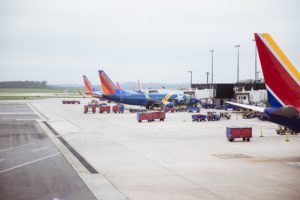Come Fly with Me: The Art of Airline Public Relations

Published on October 17, 2018, at 7:45 p.m.
by Emily Hillhouse.
Aside from being the largest U.S. domestic airline, Southwest Airlines has a reputation in the communications industry for superior branding and customer loyalty. Recently ranked in Fortune’s 2018 list of World’s Most Admired Companies for the 24th consecutive year, it frequently garners recognition for customer service and corporate social responsibility.
For public relations practitioners, there are a myriad of factors that make working for an airline unique from other areas in the communications industry. Looking at Southwest Airlines for example, there are many aspects of the airline industry that are crucial for communicators to understand.
The industry’s complexity
In order to communicate effectively for an organization, one must fully be immersed in its industry. The same principle goes for airlines, but with the complexity of the industry comes the need for even greater comprehension.
Alyssa Comins, a former Southwest external communications intern, said that this complexity results in communicators in the airline industry having to be comfortable in an environment in which their work is “under a microscope.”

“The airline industry is kind of complex, and running an airline is complex,” she said. “There are a lot of things that an airline can’t do or won’t do from a public relations standpoint just because it works in an industry that is regulated very heavily.”
Communicators must be aware of these regulations, primarily coming from the Federal Aviation Administration (FAA) and the U.S. Department of Transportation (DOT). According to Katie Gatti, an assistant manager and copywriter at Southwest Airlines, this is especially important when it comes to promoting the airline’s sales.
“There are a lot of laws around the way airlines are allowed to advertise fares. You have to have a certain number of fares that are available at that price, for that market, in order to even call something a sale,” Gatti said. “You can still have fun with it, but I think it is challenging because you are always trying to walk that line, and you don’t want to say anything that is going to implicate the airline.”
One must also be aware of specific terms their organization uses. Comins noted that she had to learn that Southwest explicitly uses “Customer,” not “passenger,” in all communications. Knowing the parts of an aircraft and their functions is also necessary in order to explain malfunctions to Customers, who will be looking to communicators for answers.

The importance of sales
Despite airline companies becoming increasingly financially reliable, investors still see the industry as risky. For this reason, it is crucial for communicators to understand the importance of sales, and in turn, their monetary impact on the airline.
On the brand team in the marketing arm of Southwest, Gatti works with the revenue management department and sale planning team to determine business objectives and messaging parameters. While the marketing team has an obvious direct impact on profits by raising awareness, it also has a significant indirect impact on investor confidence through sales.
“The better the sales do, and the better we are about getting the word out, indirectly influences the market. Because when we report higher earnings, the share price goes up,” Gatti said. “If we do our jobs appropriately and can market our sale fares and market the brand well, then we make more money, and then shareholders and investors are more interested in jumping on board.”
This is just one of the many reasons airline public relations is so consumer-focused.
The intensity of crises in the airlines industry
For some industries, the biggest crisis one might need to navigate is a recall, or a scandal, and if the communications team is lucky, it will be impersonal and standard. For airlines, crises range from all of the above, in addition to tragedies that not only result in decreased trust, but lives lost.
Above all else, communicators in this industry need to remember to maintain transparency with their audiences, whether they are media, Twitter followers or family members. Also, in times of peace, communicators need to be establishing goodwill and brand trust with these audiences in order to build equity that the company will need in a crisis.
“People that trust a brand already, they are going to be much forgiving if things go wrong, and they are going to be much more accommodating,” Gatti said. “Whereas if you don’t have a strong brand, and you do lack that goodwill, that trust, it’s going to be much harder to come back from crises.”

The need for an aware, proactive social media presence
Today, communications teams in all industries utilize social media to engage with their audiences. For airlines, however, social media is a different beast altogether. With weather conditions and flight statuses being up in the air, no pun intended, many airline customers take to social media to find answers and express grievances, which Comins quickly realized in her work for Southwest’s communications and outreach department.
“This can happen in any industry, but especially an airline, you can tweet something like ‘Where are you going this Friday?’ and all of the responses are complaints,” Comins said. “‘My plane is delayed,’ ‘Why did you cancel my flight?’”
With more online and public customer complaints than other industries, it is no surprise why some airlines have began to use private messaging to communicate with frustrated customers whenever possible.
Southwest has also addressed the negative features of airline social media by proactively seeking out opportunities from the digital landscape to tell positive, uplifting stories. For example, when a mother from Albuquerque posted on Facebook about a Southwest pilot waving back at her five-year-old son, Southwest invited the boy to meet and tour an aircraft with the pilot. The campaign garnered positive feedback and a slew of earned media spots.

The personal element of travel
People buy plane tickets for weddings, funerals, vacations and so much more. The personal nature of air travel means there are endless stories to tell, and Southwest has identified and tapped into this opportunity with its “Every seat is a story” campaign.
For this campaign, 175 customer stories were told, representing the 175 seats on its new Boeing 737 MAX 8 aircraft. Southwest used platforms ranging from television ads to an interactive microsite to share the stories of these individuals and their travels through some of life’s most emotional moments.
This campaign reiterates Southwest’s purpose, “To connect People to what’s important in their lives through friendly, reliable, and low-cost air travel.” It also represents what communicators in the airline industry can accomplish when they recognize what makes their industry special — the people.
The evolutionary nature of branding
At the end of the day, all public relations practitioners must practice flexibility in their vision. No brand, even one like Southwest, should remain static.
“The biggest misconception I had was that the brand stays the same, and it’s just your job to bolster it. That is not the case,” Gatti said. “You can’t change things that you have identified as quintessential to the brand. ‘Bags fly free’ will probably never change. But there are elements that will change over time.”
“In order to stay relevant, we have to think, ‘What’s going to push the brand forward now? What’s next?’”
Communicators in the airline industry should strive to practice this attentiveness, while remaining people-focused and building trust and loyalty surrounding their brand. That is what gets messages off the ground.




